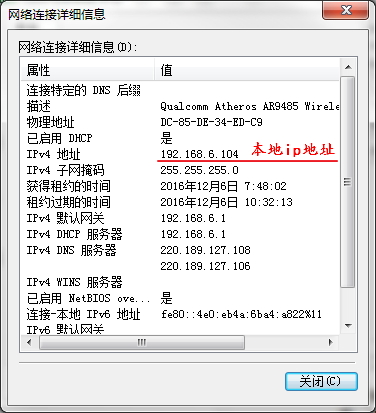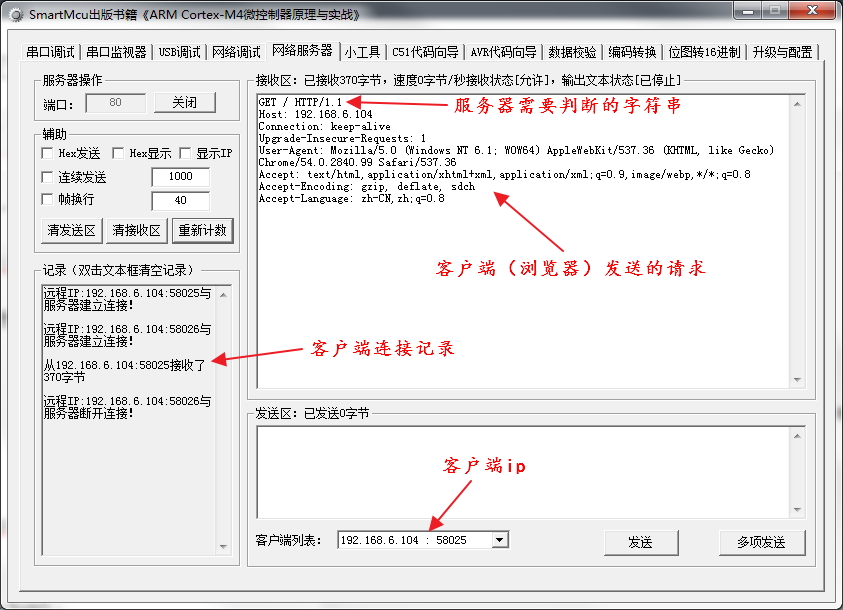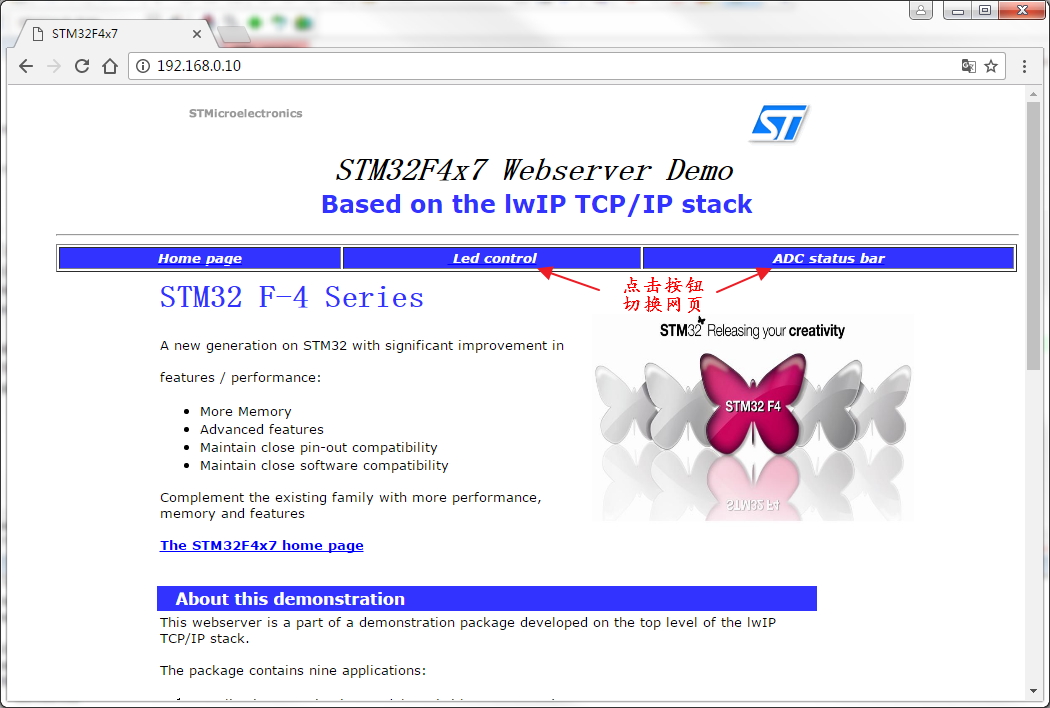本篇目标:在之前能ping通pc机的工程基础上搭建web服务器,借鉴官方web服务器的程序与网页,能够用pc机浏览器访问web服务器,并返回设置的网页
材料准备:
- 基础工程:修改后能ping通pc机的工程(STM32官方移植lwip修改代码)
- 搭建工程:最终搭建好的web服务器工程(STM32搭建web服务器工程)
- 调试工具:用来调试tcp连接下的数据接收(网络调试助手)
- 测试浏览器:这里使用的是Chrome谷歌浏览器
ps:通过修改官方搭建web服务器的代码,来了解搭建的过程,其中暂时去掉了ssi和cgi的程序,仅仅实现网页数据的返回和网页的跳转,并将官方的代码简化到相对最简,以便以后的学习之用
浏览器请求指令探索
要搭建服务器,首先肯定要先了解远程客户端是怎么访问服务器的,这里pc机的浏览器则作为客户端:
- 打开浏览器(谷歌浏览器测试),输入服务器ip;
- 浏览器发送请求命令给服务器;
- 服务器接收到指令后,通过程序来解析指令,找到对应应该返回的网页;
- 服务器发送网页代码给浏览器;
- 浏览器显示网页;
接下来再用搭建虚拟服务器的方法,来模拟一下上面的过程:
打开网络调试助手,切换到网络服务器,在服务器操作端口输入80,点击创建,如图;这样我们就创建了一个虚拟的服务器,这个服务器的ip就是pc机的本地ip
查看确认一下本地ip地址,可以在网络连接里面查看,也可以在cmd输命令查看,这里的ip地址为192.168.6.104,如图:
打开浏览器(谷歌浏览器测试),输入刚才确认的本地ip地址,这里输入192.168.6.104:
返回去看看刚才搭建的服务器有什么变化,会发现有接收到的数据,只要重点观察第一行的数据“GET / HTTP/1.1”,这个字符串将会被服务器解析,然后将网页代码返回回去:
找到一个官方程序有一个fs文件夹,里面有已经做好的网页,打开网页index.html,右击-查看源代码,然后全选复制下来,在网络调试助手的发送区粘贴,并点击发送,如图:
这时,会发现浏览器已经显示了一张网页,但是好像又有点不全,因为图片没有显示,为什么呢?返回网络调试助手,发现接收区又有好多请求,看字面意思,好像就是图片的请求,然而服务器没有返回图片数据,所以图片无法显示
这时候,将所有的浏览器请求列出来比较一下:
“GET / HTTP/1.1”
“GET /STM32F4x7_files/ST.gif HTTP/1.1”
“GET /inchtml-pages-stm32_connectivity_files/pixel.gif HTTP/1.1”
“GET /STM32F4x7_files/stm32.jpg HTTP/1.1”
发现请求中 / 后面一部分的内容不相同,所以服务器只需要解析这一部分的字符串内容,来返回对应的网页数据即可
搭建web服务器
现在创建一个新的c文件,取名为 http_server.c ,接下来写几个函数来建立web服务器,抽重要的函数进行总结一下:
- web服务器初始化函数 Http_Server_Init():
void Http_Server_Init(void)
{
struct tcp_pcb *http_server_pcb;
/* 为web服务器分配一个tcp_pcb结构体 */
http_server_pcb = tcp_new();
/* 绑定本地端号和IP地址 */
tcp_bind(http_server_pcb, IP_ADDR_ANY, 80);
/* 监听之前创建的结构体http_server_pcb */
http_server_pcb = tcp_listen(http_server_pcb);
/* 初始化结构体接收回调函数 */
tcp_accept(http_server_pcb, http_server_accept);
}小结:上面函数主要就是为搭建web服务器做准备,包括申请网络结构体、设置80端口号、监听数据、设置接收数据回调函数;
- 接收数据回调函数 tcp_server_accept() :
static err_t http_server_accept(void *arg, struct tcp_pcb *pcb, err_t err)
{
struct http_state *hs;
/* 分配内存空间 */
hs = (struct http_state *)mem_malloc(sizeof(struct http_state));
if (hs != NULL)
{
memset(hs, 0, sizeof(struct http_state));
}
/* 确认监听和连接 */
tcp_arg(pcb, hs);
/* 配置接收回调函数 */
tcp_recv(pcb, http_server_recv);
/* 配置轮询回调函数 */
tcp_poll(pcb, http_server_poll, 4);
/* 配置发送回调函数 */
tcp_sent(pcb, http_sent);
return ERR_OK;
}小结:函数中主要配置一些回调函数,比如接收,轮询,发送;
- 接收数据处理函数 http_server_recv() :
static err_t http_server_recv(void *arg, struct tcp_pcb *pcb, struct pbuf *http_recv_pbuf, err_t err)
{
err_t parsed = ERR_ABRT;
struct http_state *hs = (struct http_state *)arg;
/* 告诉tcp已经接收到数据 */
tcp_recved(pcb, http_recv_pbuf->tot_len);
if (hs->handle == NULL)
{
/* 解析接收到的浏览器请求数据 */
parsed = http_parse_request(&http_recv_pbuf, hs, pcb);
}
/* 清空请求字符串 */
if (parsed != ERR_INPROGRESS)
{
if (hs->req != NULL)
{
pbuf_free(hs->req);
hs->req = NULL;
}
}
if (parsed == ERR_OK)
{
/* 发送网页数据 */
http_send_data(pcb, hs);
}
else if (parsed == ERR_ARG)
{
/* 关闭连接 */
close_conn(pcb, hs);
}
return ERR_OK;
}小结:函数主要工作将接收到的数据放入 http_parse_request() 函数进行解析,然后把网页数据发送出去;
- 接收数据解析函数 http_parse_request():
static err_t http_parse_request(struct pbuf **inp, struct http_state *hs, struct tcp_pcb *pcb)
{
char *data;
char *crlf;
u16_t data_len;
struct pbuf *p = *inp;
char *sp1, *sp2;
u16_t uri_len;
char *uri;
/* 排列字符串 */
if (hs->req == NULL)
{
hs->req = p;
}
else
{
/* 将多次的请求字符串进行连接排序 */
pbuf_cat(hs->req, p);
}
/* 拷贝输入数据 */
if (hs->req->next != NULL)
{
data_len = hs->req->tot_len;
pbuf_copy_partial(hs->req, data, data_len, 0);
}
else
{
data = (char *)p->payload;
data_len = p->len;
}
/* 提取接收到的浏览器字符串,浏览器请求示例:"GET / HTTP/1.1" */
if (data_len > 7)
{
crlf = strstr(data, "\r\n");
if (crlf != NULL)
{
/* 比较前4个字符是否为 "GET " */
if (strncmp(data, "GET ", 4) == 0)
{
/* sp1指向字符串 "/ HTTP/1.1" */
sp1 = (data + 4);
}
/* 在sp1字符串中寻找字符" ",sp2指向字符串 " HTTP/1.1" */
sp2 = strstr(sp1, " ");
/* uri_len获取sp1字符串首地址到sp2字符串首地址的长度 */
uri_len = sp2 - (sp1);
if ((sp2 != 0) && (sp2 >= (sp1)))
{
/* 将解析的字符串赋给uri,并在最后加上结束符\0,
uri指向字符串 "/\0" */
uri = sp1;
*(sp1 - 1) = 0;
uri[uri_len] = 0;
/* 根据字符串寻找对应网页数据 */
return http_find_file(hs, uri, 0);
}
}
}
return ERR_OK;
}小结:这个函数是重要的请求数据解析函数,函数将接收到的字符串(例:“GET /STM32F4x7_files/ST.gif HTTP/1.1”)
分离出重要的判断字符串(例:“ /STM32F4x7_files/ST.gif”),然后根据这个字符串的内容来读取对应的网页数据;
- 读取对应网页数据函数 http_find_file():
static err_t http_find_file(struct http_state *hs, const char *uri, int is_09)
{
struct fs_file *file = NULL;
/* 如果字符串为 "/\0",则打开index网页 */
if((uri[0] == '/') && (uri[1] == 0))
{
file = fs_open("/index.html");
uri = "/index.html";
}
else
{
/* 如果为其他请求,则打开相应网页 */
file = fs_open(uri);
}
/* 将网页文件数据赋值给http_state结构体,之后发送出去 */
return http_init_file(hs, file, is_09, uri);
}小结:此函数就是网页数据读取函数,里面最重要的函数就是 fs_open() 函数了,这个函数在官方建立web服务器工程里的 fs.c 文件里面,这个函数的解析放到后面;
ps:http_server.c 还有头文件的包含,函数的定义;另外再编写一个http_server.h文件,包含宏定义,结构体定义,函数定义;在下面贴出这两个文件的源码;
上面基本包括了几个重要的函数,当然还有其他的函数,包括发送函数等等,这些函数可以看源代码的注释来理解
文件源码
- http_server.c
#include "lwip/debug.h"
#include "lwip/stats.h"
#include "lwip/tcp.h"
#include "http_server.h"
#include "fs.h"
#include <string.h>
#include <stdio.h>
#include <stdlib.h>
/*
*********************************************************************************************************
* LOCAL TABLES
*********************************************************************************************************
*/
static err_t http_server_accept(void *arg, struct tcp_pcb *pcb, err_t err);
static err_t http_server_recv(void *arg, struct tcp_pcb *pcb, struct pbuf *tcp_recv_pbuf, err_t err);
static err_t http_server_poll(void *arg, struct tcp_pcb *pcb);
static err_t http_init_file(struct http_state *hs, struct fs_file *file, int is_09, const char *uri);
static err_t http_find_file(struct http_state *hs, const char *uri, int is_09);
static err_t http_parse_request(struct pbuf **inp, struct http_state *hs, struct tcp_pcb *pcb);
static u8_t http_send_data(struct tcp_pcb *pcb, struct http_state *hs);
static err_t http_sent(void *arg, struct tcp_pcb *pcb, u16_t len);
static void close_conn(struct tcp_pcb *pcb, struct http_state *hs);
/*
*********************************************************************************************************
* LOCAL FUNCTION PROTOTYPES
*********************************************************************************************************
*/
/***
* 函数名称 : Http_Server_Init();
*
* 函数描述 : web服务器初始化;
*
* 传递值 : 无;
*
* 返回值 : 无;
*
**/
void Http_Server_Init(void)
{
struct tcp_pcb *http_server_pcb;
/* 为web服务器分配一个tcp_pcb结构体 */
http_server_pcb = tcp_new();
/* 绑定本地端号和IP地址 */
tcp_bind(http_server_pcb, IP_ADDR_ANY, 80);
/* 监听之前创建的结构体http_server_pcb */
http_server_pcb = tcp_listen(http_server_pcb);
/* 初始化结构体接收回调函数 */
tcp_accept(http_server_pcb, http_server_accept);
}
/***
* 函数名称 : http_server_accept();
*
* 函数描述 : lwip数据接收回调函数,包含对tcp连接的确认,接收回调函数的配置;
*
* 传递值 : *arg, *pcb, err ;
*
* 返回值 : ERR_OK 无错误;
*
**/
static err_t http_server_accept(void *arg, struct tcp_pcb *pcb, err_t err)
{
struct http_state *hs;
/* 分配内存空间 */
hs = (struct http_state *)mem_malloc(sizeof(struct http_state));
if (hs != NULL)
{
memset(hs, 0, sizeof(struct http_state));
}
/* 确认监听和连接 */
tcp_arg(pcb, hs);
/* 配置接收回调函数 */
tcp_recv(pcb, http_server_recv);
/* 配置轮询回调函数 */
tcp_poll(pcb, http_server_poll, 4);
/* 配置发送回调函数 */
tcp_sent(pcb, http_sent);
return ERR_OK;
}
/***
* 函数名称 : http_server_recv();
*
* 函数描述 : 接受到数据后,根据接收到数据的内容,返回网页;
*
* 传递值 : *arg, *pcb, *http_recv_pbuf, err;
*
* 返回值 : ERR_OK无错误;
*
**/
static err_t http_server_recv(void *arg, struct tcp_pcb *pcb, struct pbuf *http_recv_pbuf, err_t err)
{
err_t parsed = ERR_ABRT;
struct http_state *hs = (struct http_state *)arg;
/* 告诉tcp已经接收到数据 */
tcp_recved(pcb, http_recv_pbuf->tot_len);
if (hs->handle == NULL)
{
/* 解析接收到的浏览器请求数据 */
parsed = http_parse_request(&http_recv_pbuf, hs, pcb);
}
/* 清空请求字符串 */
if (parsed != ERR_INPROGRESS)
{
if (hs->req != NULL)
{
pbuf_free(hs->req);
hs->req = NULL;
}
}
if (parsed == ERR_OK)
{
/* 发送网页数据 */
http_send_data(pcb, hs);
}
else if (parsed == ERR_ARG)
{
/* 关闭连接 */
close_conn(pcb, hs);
}
return ERR_OK;
}
/***
* 函数名称 : http_server_poll();
*
* 函数描述 : 轮询函数;
*
* 传递值 : *arg, *pcb;
*
* 返回值 : ERR_OK无错误;
*
**/
static err_t http_server_poll(void *arg, struct tcp_pcb *pcb)
{
struct http_state *hs = arg;
if (hs == NULL)
{
close_conn(pcb, hs);
return ERR_OK;
}
else
{
hs->retries++;
if (hs->retries == 4)
{
close_conn(pcb, hs);
return ERR_OK;
}
/* 如果连接存在打开的文件,则将会发送剩下的数据;
* 如果一直没有收到GET请求,那么连接将会立刻关闭 */
if (hs && (hs->handle))
{
if (http_send_data(pcb, hs))
{
tcp_output(pcb);
}
}
}
return ERR_OK;
}
/***
* 函数名称 : http_parse_request();
*
* 函数描述 : 对接收到的数据进行解析,根据不同的浏览器请求,返回对应的网页数据;
*
* 传递值 : **inp, *hs, *pcb;
*
* 返回值 : ERR_OK无错误;
*
**/
static err_t http_parse_request(struct pbuf **inp, struct http_state *hs, struct tcp_pcb *pcb)
{
char *data;
char *crlf;
u16_t data_len;
struct pbuf *p = *inp;
char *sp1, *sp2;
u16_t uri_len;
char *uri;
/* 排列字符串 */
if (hs->req == NULL)
{
hs->req = p;
}
else
{
/* 将多次的请求字符串进行连接排序 */
pbuf_cat(hs->req, p);
}
/* 拷贝输入数据 */
if (hs->req->next != NULL)
{
data_len = hs->req->tot_len;
pbuf_copy_partial(hs->req, data, data_len, 0);
}
else
{
data = (char *)p->payload;
data_len = p->len;
}
/* 提取接收到的浏览器字符串,浏览器请求示例:"GET / HTTP/1.1" */
if (data_len > 7)
{
crlf = strstr(data, "\r\n");
if (crlf != NULL)
{
/* 比较前4个字符是否为 "GET " */
if (strncmp(data, "GET ", 4) == 0)
{
/* sp1指向字符串 "/ HTTP/1.1" */
sp1 = (data + 4);
}
/* 在sp1字符串中寻找字符" ",sp2指向字符串 " HTTP/1.1" */
sp2 = strstr(sp1, " ");
/* uri_len获取sp1字符串首地址到sp2字符串首地址的长度 */
uri_len = sp2 - (sp1);
if ((sp2 != 0) && (sp2 >= (sp1)))
{
/* 将解析的字符串赋给uri,并在最后加上结束符\0,
uri指向字符串 "/\0" */
uri = sp1;
*(sp1 - 1) = 0;
uri[uri_len] = 0;
/* 根据字符串寻找对应网页数据 */
return http_find_file(hs, uri, 0);
}
}
}
return ERR_OK;
}
/***
* 函数名称 : http_find_file();
*
* 函数描述 : 对提取的数据进行判断,读取对应的网页数据;
*
* 传递值 : *hs, *uri, is_09;
*
* 返回值 : ERR_OK无错误;
*
**/
static err_t http_find_file(struct http_state *hs, const char *uri, int is_09)
{
struct fs_file *file = NULL;
/* 如果字符串为 "/\0",则打开index网页 */
if((uri[0] == '/') && (uri[1] == 0))
{
file = fs_open("/index.html");
uri = "/index.html";
}
else
{
/* 如果为其他请求,则打开相应网页 */
file = fs_open(uri);
}
/* 将网页文件数据赋值给http_state结构体,之后发送出去 */
return http_init_file(hs, file, is_09, uri);
}
/***
* 函数名称 : http_init_file();
*
* 函数描述 : 将要发送的数据保存到http_state结构体当中;
*
* 传递值 : *hs, *file, is_09, *uri;
*
* 返回值 : ERR_OK无错误;
*
**/
static err_t http_init_file(struct http_state *hs, struct fs_file *file, int is_09, const char *uri)
{
if (file != NULL)
{
hs->handle = file;
/* 将网页数据赋值给http_state */
hs->file = (char*)file->data;
/* 将网页长度赋值给http_state */
hs->left = file->len;
hs->retries = 0;
}
else
{
hs->handle = NULL;
hs->file = NULL;
hs->left = 0;
hs->retries = 0;
}
return ERR_OK;
}
/***
* 函数名称 : http_send_data();
*
* 函数描述 : 数据发送函数;
*
* 传递值 : *pcb, *hs;
*
* 返回值 : ERR_OK无错误;
*
**/
static u8_t http_send_data(struct tcp_pcb *pcb, struct http_state *hs)
{
err_t err = ERR_OK;
u16_t len;
u8_t data_to_send = 0;
/* 配置发送数据长度,如果发送数据过长则分批发送 */
if (tcp_sndbuf(pcb) < hs->left)
{
len = tcp_sndbuf(pcb);
}
else
{
len = (u16_t)hs->left;
}
/* 发送网页数据 */
err = tcp_write(pcb, hs->file, len, 1);
if (err == ERR_OK)
{
data_to_send = 1;
hs->file += len;
hs->left -= len;
}
if ((hs->left == 0) && (fs_bytes_left(hs->handle) <= 0))
{
/* 关闭连接 */
close_conn(pcb, hs);
return 0;
}
return data_to_send;
}
/***
* 函数名称 : http_sent();
*
* 函数描述 : 数据已经被发送,并且被远程主机确定;
*
* 传递值 : *arg, *pcb, len;
*
* 返回值 : ERR_OK无错误;
*
**/
static err_t http_sent(void *arg, struct tcp_pcb *pcb, u16_t len)
{
struct http_state *hs = (struct http_state *)arg;
if (hs == NULL)
{
return ERR_OK;
}
hs->retries = 0;
http_send_data(pcb, hs);
return ERR_OK;
}
/***
* 函数名称 : close_conn();
* * 函数描述 : 关闭tcp连接;
* * 传递值 : *pcb, *hs;
* * 返回值 : 无;
* **/
static void close_conn(struct tcp_pcb *pcb, struct http_state *hs)
{
tcp_arg(pcb, NULL);
tcp_recv(pcb, NULL);
tcp_err(pcb, NULL);
tcp_poll(pcb, NULL, 0);
tcp_sent(pcb, NULL);
if (hs != NULL)
{
if(hs->handle)
{
fs_close(hs->handle);
hs->handle = NULL;
}
mem_free(hs);
}
tcp_close(pcb);
}- http_server.h
#ifndef HTTP_SERVER_H
#define HTTP_SERVER_H
/*
*********************************************************************************************************
* INCLUDE FILES
*********************************************************************************************************
*/
/*
*********************************************************************************************************
* CONSTANTS
*********************************************************************************************************
*/
/*
*********************************************************************************************************
* PERIPH DEFINES
*********************************************************************************************************
*/
/*
*********************************************************************************************************
* DATA TYPES
*********************************************************************************************************
*/
/*
*********************************************************************************************************
* GLOBAL VARIABLES
*********************************************************************************************************
*/
struct http_state {
struct fs_file *handle;
char *file; /* Pointer to first unsent byte in buf. */
#if 1
struct pbuf *req;
#endif /* LWIP_HTTPD_SUPPORT_REQUESTLIST */
#if 1
char *buf; /* File read buffer. */
int buf_len; /* Size of file read buffer, buf. */
#endif /* LWIP_HTTPD_SSI || LWIP_HTTPD_DYNAMIC_HEADERS */
u32_t left; /* Number of unsent bytes in buf. */
u8_t retries;
#if 0
const char *parsed; /* Pointer to the first unparsed byte in buf. */
#if 1
const char *tag_started;/* Poitner to the first opening '<' of the tag. */
#endif /* !LWIP_HTTPD_SSI_INCLUDE_TAG */
const char *tag_end; /* Pointer to char after the closing '>' of the tag. */
u32_t parse_left; /* Number of unparsed bytes in buf. */
u16_t tag_index; /* Counter used by tag parsing state machine */
u16_t tag_insert_len; /* Length of insert in string tag_insert */
#if 0
u16_t tag_part; /* Counter passed to and changed by tag insertion function to insert multiple times */
#endif /* LWIP_HTTPD_SSI_MULTIPART */
u8_t tag_check; /* true if we are processing a .shtml file else false */
u8_t tag_name_len; /* Length of the tag name in string tag_name */
char tag_name[LWIP_HTTPD_MAX_TAG_NAME_LEN + 1]; /* Last tag name extracted */
char tag_insert[LWIP_HTTPD_MAX_TAG_INSERT_LEN + 1]; /* Insert string for tag_name */
enum tag_check_state tag_state; /* State of the tag processor */
#endif /* LWIP_HTTPD_SSI */
#if 0
char *params[LWIP_HTTPD_MAX_CGI_PARAMETERS]; /* Params extracted from the request URI */
char *param_vals[LWIP_HTTPD_MAX_CGI_PARAMETERS]; /* Values for each extracted param */
#endif /* LWIP_HTTPD_CGI */
#if 0
const char *hdrs[NUM_FILE_HDR_STRINGS]; /* HTTP headers to be sent. */
u16_t hdr_pos; /* The position of the first unsent header byte in the
current string */
u16_t hdr_index; /* The index of the hdr string currently being sent. */
#endif /* LWIP_HTTPD_DYNAMIC_HEADERS */
#if 0
u32_t time_started;
#endif /* LWIP_HTTPD_TIMING */
#if 0
u32_t post_content_len_left;
#if 0
u32_t unrecved_bytes;
struct tcp_pcb *pcb;
u8_t no_auto_wnd;
#endif /* LWIP_HTTPD_POST_MANUAL_WND */
#endif /* LWIP_HTTPD_SUPPORT_POST*/
};
/*
*********************************************************************************************************
* MACRO'S
*********************************************************************************************************
*/
/*
*********************************************************************************************************
* FUNCTION PROTOTYPES
*********************************************************************************************************
*/
void Http_Server_Init(void);
/*
********************************************************************************************************
* MODULE END
*********************************************************************************************************
*/
#endif /* HTTP_SERVER_H */官方部分函数解析
读取网页数据文件 fs.c (路径:Project->Standalone->web_server->http):
struct fs_file *fs_open(const char *name)
{
struct fs_file *file;
const struct fsdata_file *f;
/* 分配空间 */
file = fs_malloc();
if(file == NULL)
{
return NULL;
}
for(f = FS_ROOT; f != NULL; f = f->next)
{
/* 循环比较,如果输入的请求与网页的头数据一致,则返回该网页数据 */
if (!strcmp(name, (char *)f->name))
{
file->data = (const char *)f->data;
file->len = f->len;
file->index = f->len;
file->pextension = NULL;
file->http_header_included = f->http_header_included;
return file;
}
}
fs_free(file);
return NULL;
}这里关注 f 变量的结构体 fsdata_file,定义在 fsdata.h:
struct fsdata_file
{
const struct fsdata_file *next;
const unsigned char *name;
const unsigned char *data;
int len;
u8_t http_header_included;
};结构体中有三个重要的变量*next、*name、*data
而在文件fsdata.c中,拉到最后,发现有几个 fsdata_file 的结构体变量,取其中一个来解析一下:
const struct fsdata_file file__index_html[] =
{
{
/* 变量*next,指向下一个要循环比较的数据 */
file__404_html,
/* 变量*name,指向数据数组 data__index_html[] */
data__index_html,
/* 变量*data,指向数据数组 data__index_html[]12个之后的数据 */
data__index_html + 12,
/* 网页数据长度 */
sizeof(data__index_html) - 12,
1,
}
};- 变量*name指向的数组前12个数据是字符串 “/index.html” 的ascii码,用于与输入的浏览器请求 “GET /index.html HTTP/1.1” 进行对比;
- 而*data指向数组的12个后的数据,便是网页源代码的16进制数据,这些数据将会由发送函数发送给浏览器,使浏览器显示网页;
web服务器测试
将工程编译后,烧进stm32,将网线与pc机连接:
- 打开浏览器(谷歌浏览器测试)
- 输入服务器ip(这里搭建的服务器ip:192.168.0.10),Enter;
- 浏览器会显示网页,点击网页上的按钮即可以切换不同的网页
如图:
总结:从上面的一系列过程可以get到搭建web服务器的核心思想,然而,现在并没有加入ssi和cgi,所以还无法用网页控制stm32,后面会加上ssi、cgi、post与get请求来完善整个web服务器;
ps:有部分细节的地方解析的不是很清楚,而且自己也没有想明白,需要再加把劲看一些其他的资料来填补空白,共勉~





